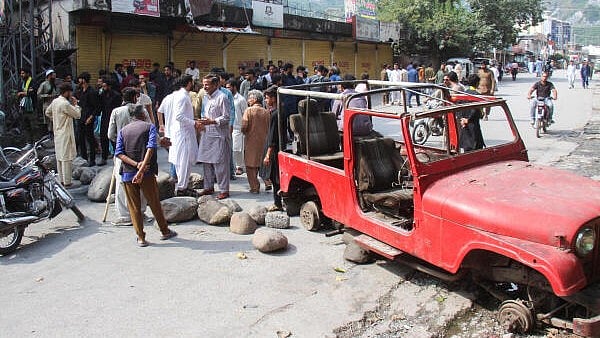
Supporters of the Joint Awami Action Committee (JAAC) block a road during a protest following a shutter-down strike in Muzaffarabad.
Credit: Reuters Photo
A tense silence has settled over Pakistan-administered Kashmir, also known as Azad Jammu and Kashmir (AJK), as the region marks its fifth consecutive day of a paralysing shutdown. Initially sparked by economic grievances, the protest has escalated into a wider grassroots movement, reflecting deep-seated public frustration.
Violent confrontations between demonstrators and security forces have claimed the lives of at least ten people, including three police officers, while leaving dozens more injured, underscoring the growing volatility in the region.
Markets remain shuttered, roads deserted, and internet and mobile networks blocked since September 28. The shutdown, spearheaded by the Jammu Kashmir Joint Awami Action Committee (JKJAAC), has brought life to a standstill across several districts. With nearly four million residents caught in the crossfire of the state’s paralysis, questions loom large: What triggered this crisis, and why are protestors refusing to back down?
From rising bills to political reform
The current unrest has its roots in May 2023, when residents poured into the streets over soaring electricity bills and shortages of subsidised flour. Anger deepened over allegations of flour smuggling and the government’s failure to ensure basic supplies.
By September that year, disparate grievances coalesced into an organised force. The JKJAAC- an umbrella platform of traders, civil society groups, and activists, led by Shaukat Nawaz Mir- emerged as the rallying point of discontent.
The movement proved its strength in May 2024, when a “long march” towards Muzaffarabad turned deadly, killing five people. That standoff ended after Islamabad stepped in with subsidies to slash flour and electricity prices.
But the relief was temporary. By August 2025, the JKJAAC declared it would broaden its campaign, releasing a 38-point charter of demands that goes far beyond cheaper bread and electricity.
The protester’s demands
At the heart of the JKJAAC’s latest agitation is the call to end what it calls “ruling elite privileges,” perks like multiple government vehicles, unlimited fuel allowances, and personal staff for ministers.
Another flashpoint is the system of 12 reserved seats in the AJK legislature for refugees from Indian-administered Kashmir, which protestors say distorts local representation and siphons development funds.
Other demands include free healthcare and education, major infrastructure projects such as tunnels and airports, employment generation, and tax exemptions. The committee has also demanded the withdrawal of legal cases filed against activists during earlier protests.
“The government promised us reforms last year but delivered little. We are tired of empty assurances,” Mir said before the blackout cut off communications across the territory.
A government caught in the middle
Islamabad has responded with a mix of concessions and force. Officials say most demands have been met, but admit deadlock over the refugee seats and the elite perks. A federal negotiating team arrived in Muzaffarabad on Thursday, even as paramilitary reinforcements and curfews underscore the fragility of peace.
Abdul Majid Khan, AJK’s Finance Minister, defended the government’s stance, “We reduced flour and electricity prices, but constitutional changes cannot happen overnight.”
“There is barely any taxation on the people here, with already reduced electricity tariffs. Additionally, we have fewer than 5,000 tax filers in the entire region, which shows little revenue generation for the government,” he added.
What lies ahead
For now, negotiations remain inconclusive, and trust between the JKJAAC and the authorities is threadbare after years of broken promises. Residents, meanwhile, remain trapped in limbo, without communication, mobility, or certainty about when normalcy will return.
Moreover, Pakistan Prime Minister Shehbaz Sharif on Thursday expressed "deep concern" over the deteriorating law and order situation in Pakistan-occupied Kashmir (PoK) as he expanded the negotiation committee to find a solution to end the violent protests.
Following this, the federal government and protesters on Saturday signed an agreement to end the ongoing demonstrations, as reported by PTI.
The team, led by former premier Raja Pervaiz Ashraf, engaged in extensive discussions for two consecutive days, which concluded around midnight. Minister for Parliamentary Affairs Tariq Fazal Chaudhry announced on social media that an agreement had been reached between the two sides.
“Negotiating delegation has signed the final agreement with the Action Committee. The protesters are returning to their homes. All roads have been reopened. This is a victory for peace,” he posed on X.
The copy of the agreement shared by Chaudhry on X showed that a detailed document with 25 points was signed to end the protest, including compensation for those killed in violence, registering cases of terrorism on the incidents of violence and vandalism resulting in deaths of police personnel and protestors.
Talking about India's take on the ongoing scenario, External Affairs ministry spokesperson Randhir Jaiswal said, "We believe that it is a natural consequence of Pakistan's oppressive approach and its systemic plundering of resources from these territories, which remain under its forcible and illegal occupation."
(With the inputs of PTI).